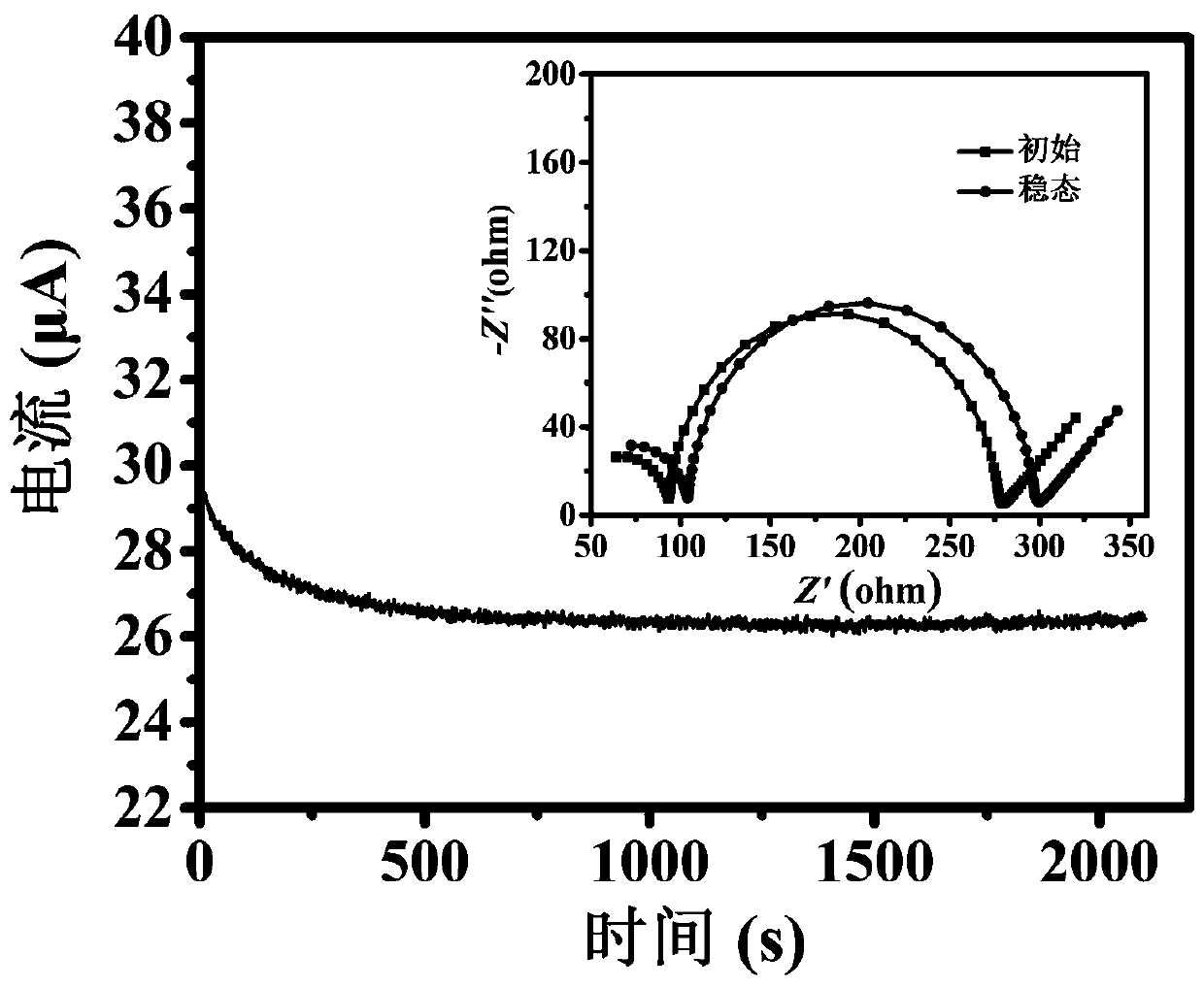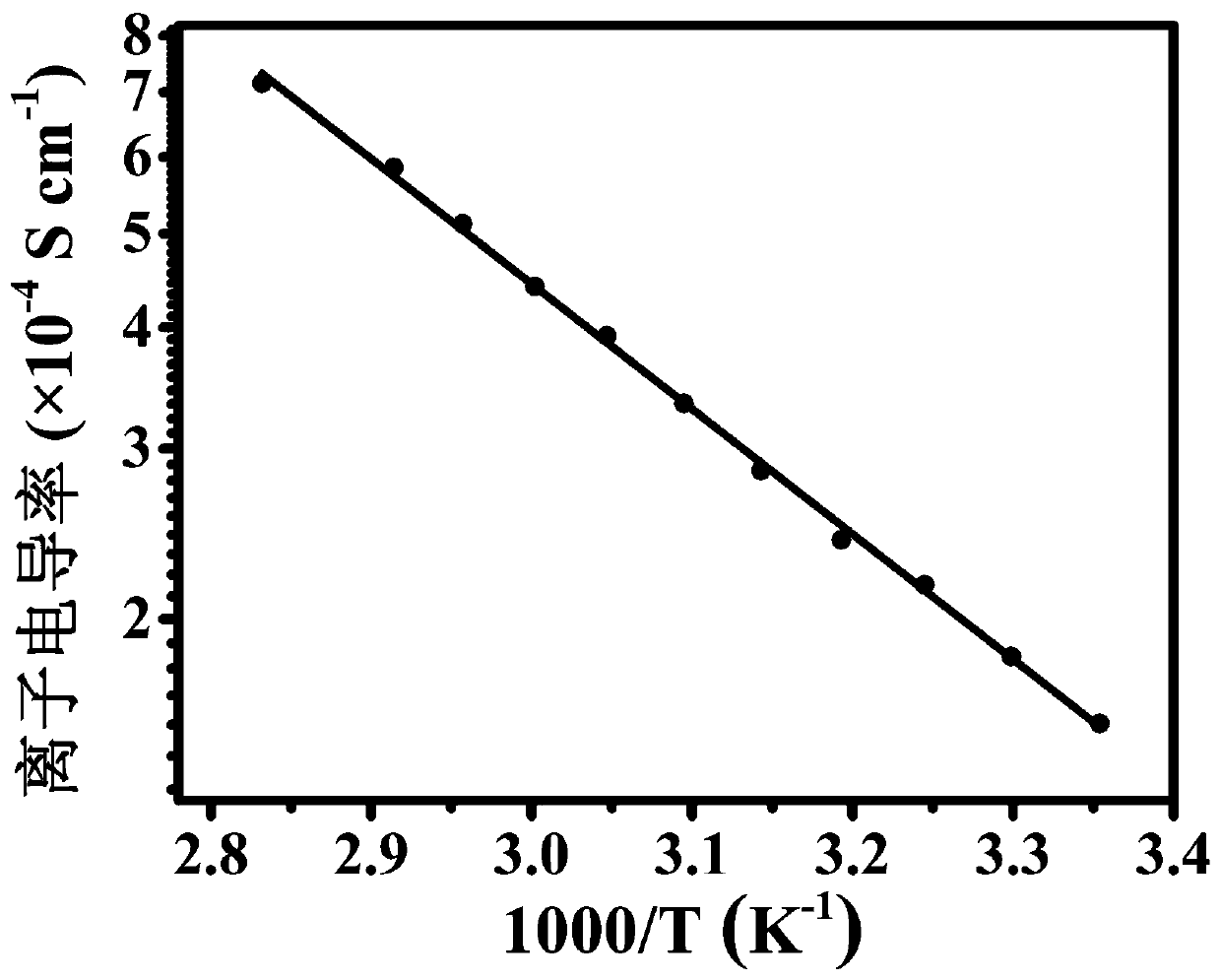Preparation and application of single-ion conductive polymer electrolyte membrane
A conductive polymer and electrolyte membrane technology, applied in solid electrolytes, non-aqueous electrolytes, circuits, etc., can solve the problems of low ion migration number and low ion conductivity, achieve excellent cycle performance, improve ion conductivity, and the method is simple Effect
- Summary
- Abstract
- Description
- Claims
- Application Information
AI Technical Summary
Problems solved by technology
Method used
Image
Examples
Embodiment 1
[0038] (1) The synthesis of the lithium-containing monomer (p-styrenesulfonyl) (trifluoromethylsulfonyl)imide lithium having the structure shown in general formula 1 is as follows:
[0039]Synthesis of p-styrenesulfonyl chloride: Add 12.0g sodium p-styrenesulfonate, 0.261g dimethylformamide and 120ml dry acetonitrile into a flask, and stir well to make the solid disperse evenly. Under an ice-water bath, 6 ml of double-distilled oxalyl chloride was added dropwise to the system under a nitrogen atmosphere, and the system returned to room temperature for 24 hours of reaction after the addition was complete. The reaction mixture was filtered to remove NaCl, and the filtrate was concentrated by rotary evaporation to remove about half of the solvent.
[0040] Synthesis of potassium (p-styrenesulfonyl)(trifluoromethylsulfonyl)imide: add 8.67g trifluoromethanesulfonamide, 0.63g dimethylaminopyridine, 24.3ml triethylamine and 100ml dry acetonitrile in a flask, Stir until all ingredien...
Embodiment 2
[0045] (1) The synthesis of the lithium-containing monomer (p-styrenesulfonyl) (fluorosulfonyl) imide lithium having the structure shown in general formula 1 is as follows:
[0046] Synthesis of p-styrenesulfonyl chloride: similar to the synthesis in Example 1, and will not be repeated here.
[0047] Synthesis of (p-styrenesulfonyl) (fluorosulfonyl) potassium imide: add 44.59g p-styrenesulfonyl chloride, 0.74g dimethylaminopyridine, 77.35g dipotassium hydrogen phosphate, 0.33g p-tert-butyl-phthalate in a flask Diphenol and 180ml of dry acetonitrile were stirred at 0°C until all components were completely dissolved. Then 20.0 g of freshly distilled fluorosulfonamide was slowly added to the flask under nitrogen atmosphere, and reacted at 25° C. for 72 hours. The precipitate was removed by filtration, and the filtrate was removed by rotary evaporation to obtain a crude product. The crude product was washed three times with 200 ml of dichloromethane, and the product was vacuum-dr...
Embodiment 3
[0052] (1) Lithium-containing monomer 1-[3-(methacryloyloxy)-(propylsulfonyl)]-1-(trifluoromethylsulfonyl)imide lithium having a structure shown in general formula 2 The synthesis is as follows:
[0053] Synthesis of 3-(chlorosulfonyl)propyl methacrylate: under an inert gas atmosphere, add 15.0g of 3-(methacryloyloxy)propyl-1-potassium sulfonate and 25ml of anhydrous Tetrahydrofuran and 1.7ml of dimethylformamide were added through a syringe, and the system was cooled to about 0°C. 39.9g thionyl chloride was added dropwise, with constant stirring, and the reaction was carried out at 0°C for 1 hour, then returned to 25°C for 12 hours. The resulting suspension was washed with 200 ml of ice water, the aqueous phase was decanted, and the lower organic phase was diluted with 80 ml of dichloromethane. The obtained dichloromethane solution was washed 6 times with 25 ml of water, and dried over anhydrous magnesium sulfate. Magnesium sulfate was removed by filtration, dichloromethan...
PUM
 Login to View More
Login to View More Abstract
Description
Claims
Application Information
 Login to View More
Login to View More - R&D
- Intellectual Property
- Life Sciences
- Materials
- Tech Scout
- Unparalleled Data Quality
- Higher Quality Content
- 60% Fewer Hallucinations
Browse by: Latest US Patents, China's latest patents, Technical Efficacy Thesaurus, Application Domain, Technology Topic, Popular Technical Reports.
© 2025 PatSnap. All rights reserved.Legal|Privacy policy|Modern Slavery Act Transparency Statement|Sitemap|About US| Contact US: help@patsnap.com



